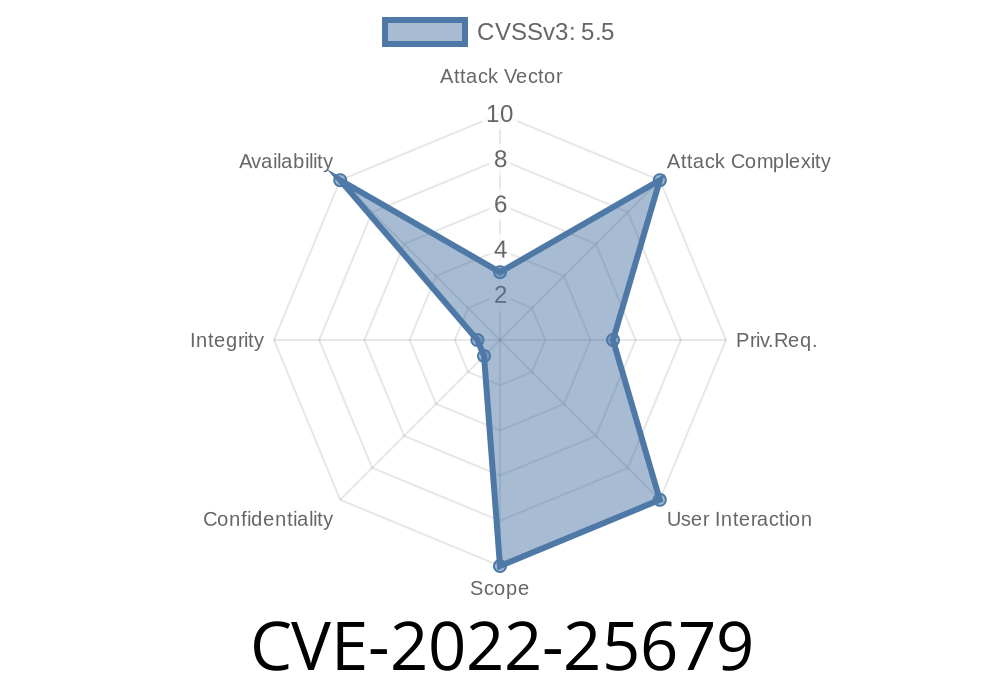The cybersecurity world is constantly faced with new threats and vulnerabilities that are discovered in software and hardware. One recent example is CVE-2022-25679, a critical vulnerability found in Qualcomm's Snapdragon chipsets. This vulnerability results in a denial of service (DoS) in video applications due to improper access control in broadcast receivers used by the chipset. In this article, we will take a closer look at the technical details of this vulnerability, discuss its impact on various Snapdragon platforms, and provide important links to original references.
Exploit Details
CVE-2022-25679 is a vulnerability that exists due to a lack of proper access control in broadcast receivers in the aforementioned Snapdragon platforms. An attacker could potentially exploit this vulnerability by sending maliciously crafted broadcasts to the target device. The target device's video application would then be forced to crash as a result, creating a denial of service situation.
The vulnerability lies in the fact that the broadcast receivers do not properly validate the sender of the broadcast or the broadcast message itself. This allows an attacker to send a specially crafted broadcast to the targeted device, which then crashes the video application.
Here is a code snippet that demonstrates a potential attack scenario
// Malicious broadcast sender
public class EvilSender extends BroadcastReceiver {
@Override
public void onReceive(Context context, Intent intent) {
Intent maliciousBroadcast = new Intent("com.vulnerable.videoapp.VULNERABLE_ACTION");
maliciousBroadcast.putExtra("malicious_data", "evil_input");
context.sendBroadcast(maliciousBroadcast);
}
}
// Vulnerable video application BroadcastReceiver
public class VulnerableReceiver extends BroadcastReceiver {
@Override
public void onReceive(Context context, Intent intent) {
String receivedData = intent.getStringExtra("malicious_data");
// Missing input validation and sender validation
processVideoData(receivedData); // application crashes due to evil_input
}
}
Mitigation and Recommendations
To prevent exploitation of CVE-2022-25679, it is crucial to update the affected platforms with the latest security patches provided by Qualcomm. As a developer, you should always follow best practices in implementing proper input validation and sender validation in broadcast receivers, as well as keeping your software up-to-date with the latest security updates.
Apply the latest security updates from Qualcomm for the affected platforms.
2. Review broadcast receiver implementations to ensure proper input validation and sender validation are in place.
3. Limit exposure of devices to potentially malicious broadcasts by hardening network configurations, implementing strong authentication, and monitoring network traffic for suspicious activities.
For more technical details and updates on this vulnerability, please refer to the official CVE entry here and the Qualcomm Security Bulletin here.
Conclusion
CVE-2022-25679 is a serious vulnerability that affects numerous Snapdragon platforms and has the potential to cause denial of service in video applications. By understanding the technical details of the vulnerability, applying the necessary security updates, and following best practices in software development, one can take steps towards mitigating the risk posed by this vulnerability and protecting their devices from potential attacks. Stay vigilant, and keep your software up-to-date with the latest security patches and best practices.
Timeline
Published on: 11/15/2022 10:15:00 UTC
Last modified on: 04/19/2023 17:10:00 UTC
